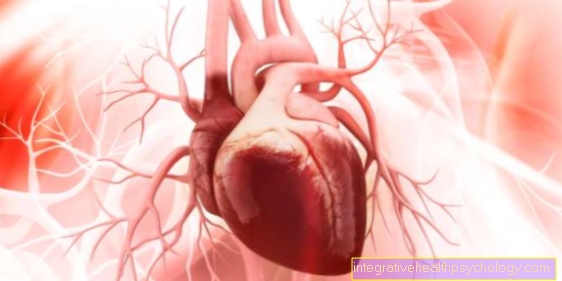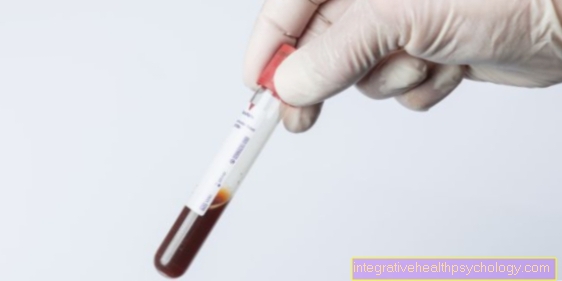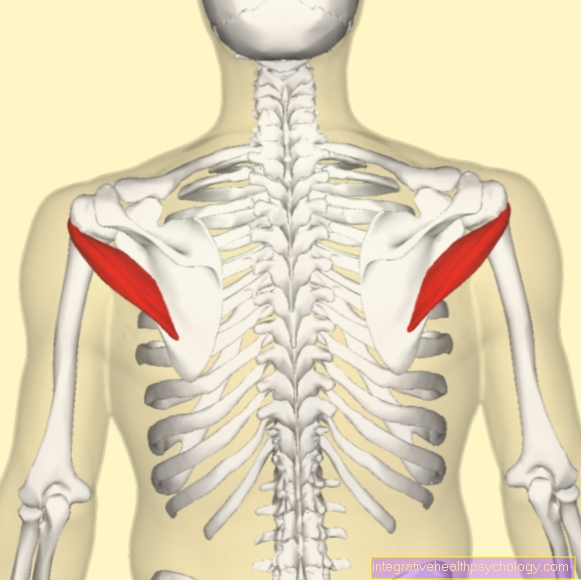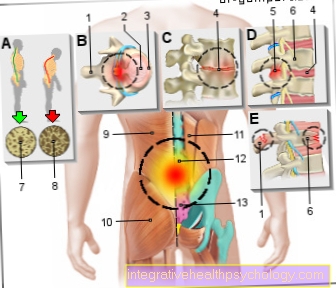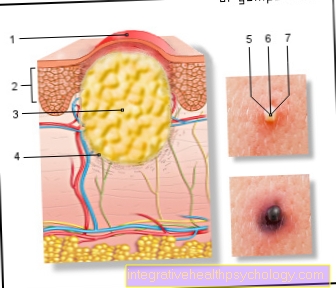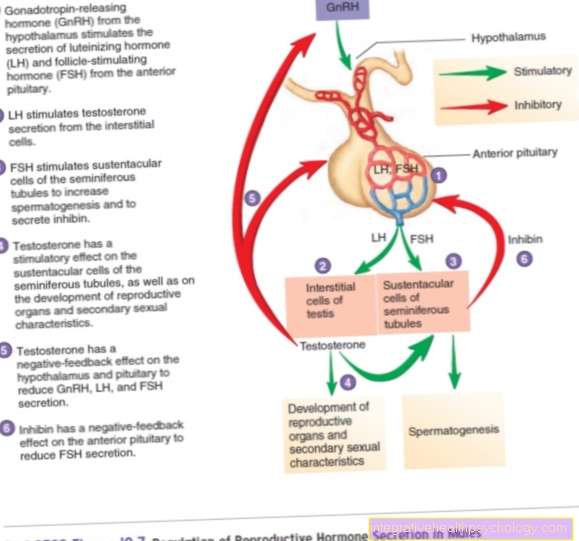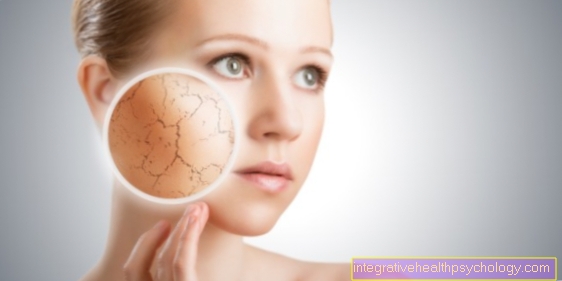Dopamine
General
Dopamine is a neurotransmitter. Similar to hormones, this is a substance that is responsible for transmitting signals in the human body.
It is called neurotransmitter because dopamine is important for the transmission of signals by neurons, i.e. nerve cells. Dopamine therefore plays an important role in the central nervous system, in the brain, and controls many processes there.
Dopamine is produced as a precursor to adrenaline and noradrenaline in the adrenal medulla and in the sympathetic nervous system. The sympathetic nervous system is responsible for activating the body.
Dopamine fulfills various tasks in the body by binding to different docking points (receptors) at different points. Depending on the type of receptor, different processes are then triggered in the body.

How does dopamine work in the body?
Dopamine is a neurotransmitter, i.e. a messenger substance of the nerve cells, which is used for communication. It belongs to the group of catecholamines, the best known representatives of which are adrenaline and noradrenaline.
The tasks of catecholamines in the body are on the one hand the mobilization of energy stores. They also regulate the cardiovascular system and cause the muscles of the vessels that supply internal organs to contract.
With its functions, dopamine has a special role, namely in many vital control and regulation processes.
In the brain, it is found in the areas of the cerebrum, diencephalon, and brain stem. It is not evenly distributed, but is concentrated in certain functional circles.
For example in the so-called limbic system, which is responsible for thinking and perception. More precisely, in the mesolimbic system, which shows increased dopamine levels when sensations of pleasure and pleasure. This is the dopamine-mediated reward system. Among other things, it is linked to “emotional memory” and the learning system.
The second important system in which dopamine occurs is called the nigrostriatal system and is located in the so-called basal ganglia. This plays an important role in regulating movements.
It inhibits excessive movements of the body and explains why, for example, patients with a dopamine deficiency can only perform strongly trembling movements.
How can you increase dopamine levels in the human body?
You cannot increase the production of dopamine in the body, but you can increase the secretion from the dopamine-producing cells into the blood.
This can be done with external substances (medication) or with certain activities.
External substances that have a strong effect on the reward system are substances that create addiction. For example, ethanol (alcohol), nicotine (cigarettes) and morphine (pain relievers).
Cocaine, amphetamines and hallucinogens also work in this way and thus justify their potential for dependence: the brain perceives a positive association with taking the drug and thus makes withdrawal more difficult.
After consuming these drugs, there is also a so-called “rebound effect”, i.e. a temporary relative dopamine deficiency.
Consumers feel tired, limp, depressed and can even be suicidal.
For the duration of consumption, the natural chemical equilibrium is severely disrupted and can even remain disturbed for life.
It is on this fact that the theory is based that drug use can cause psychosis and schizophrenia. An underlying dopamine deficiency is suspected or recognized as the cause of a number of diseases.
Their therapeutic drugs are either dopamine reuptake inhibitors or dopamine release enhancers. This means the dopamine release from the neurons to other neighboring target neurons or the space between several neurons (synaptic gap): Neurotransmitters are subject to natural "recycling". The reuptake inhibitors take advantage of this and thus increase the dopamine level.
If a patient no longer produces their own dopamine at all, they can be given a precursor called L-DOPA. This precursor form reaches the central nervous system from the blood of the gastrointestinal tract, where it is converted into dopamine.
Non-medication activities that increase dopamine levels include enjoyable activities: eating, exercising, sex, or other rewarding activities.
With regard to food, you can make sure that you get enough of the amino acids that are important for dopamine production.
Studies have so far not been able to prove whether this can really prevent a dopamine deficiency. Nevertheless, testimonials from many people point to this.
Foods that provide dopamine building blocks are those that are rich in the amino acids tyrosine and phenylalanine.
These include avocados, bananas, lima beans, sesame seeds, pumpkin seeds, and almonds. Soy products and low-fat dairy and meat products. Studies have so far not shown an increased increase in dopamine for the consumption of chocolate.
Vitamin B6 and L-phenylalanine are freely available in pharmacies and can also be used as dietary supplements. Since an overdose is possible here in principle and can then be very dangerous, this should only take place in consultation with a doctor.
Regular, gentle endurance sport increases the concentration of calcium in the blood, which in turn supports dopamine production in the neurons. Jogging, swimming or cycling for 30 minutes 2-3 times a week seem to have a protective function against dopamine deficiency.
Similar to sex, many hormones are released during exercise that affect the reward system. These are oxytocin and adrenaline, which increase the feeling of reward.
Dopamine Associated Diseases
Since dopamine is responsible for many different processes in the body, many diseases are attributed to impaired dopamine production. There can either be an overproduction or an underproduction of dopamine, which lead to various clinical pictures.
Underproduction
Dopamine plays a major role in Parkinson's disease. There is a dopamine deficiency here, which prevents the commands that the brain sends to the arms and legs to move from being precisely coordinated. Movements are no longer regulated in terms of their extent and direction and the result is uncoordinated and involuntary movements, which are typical for Parkinson's disease. Since the reward system and thus the positive sensations are also controlled by dopamine, a dopamine deficiency can also lead to depression.
Overproduction
Overproduction of dopamine is often caused by a tumor in the adrenal medulla (pheochromocytoma).
Dopamine is responsible for positive sensations and feelings and for their transmission in the brain. If there is too much dopamine, these people perceive much more of the external impressions than people with normal dopamine levels can. Too many impressions can lead to a nervous breakdown. In addition, dopamine is ascribed an important role in schizophrenia and other psychoses. Here it is said to be responsible for the "positive" symptoms of the disorders.
Overproduction of dopamine often manifests itself in symptoms such as high blood pressure, sweating and headaches.
In some cases, a short-term overproduction of dopamine is not a disease. When there is an acute lack of sleep, the body produces more dopamine in order to stimulate it.
Disruption of degradation
ADD and ADHD as attention deficit syndromes are also based on a disorder of the dopamine level. In these cases, the dopamine is broken down too quickly and the brain is no longer able to filter incoming external stimuli. So unimportant impressions cannot be sorted out and concentration and attention disorders arise.
Dopamine deficiency
A dopamine deficiency can arise after drug abuse, for example, when dopamine is no longer evenly distributed in the brain. Instead, it concentrates in the wrong areas and is scarce in others.
There are also several important diseases that are caused by a dopamine deficiency. What they all have in common is that the dopamine producing or consuming neurons perish over time. The cause of this cannot yet be adequately explained.
These diseases are Parkinson's disease, restless legs syndrome, and ADHD.
At least in Parkinson's disease, it is now assumed that the disease originally comes from the intestine and induces a breakdown of dopaminergic neurons in the brain via neuronal pathways.
In all three diseases, the patient's "fidgeting impression" dominates.
Since dopamine has an inhibiting role in the movement processes of the brain, patients show excessive movements when it is deficient. One can try to increase the dopamine level with medication over a certain period of time. For this purpose, drugs are used that promote the body's own dopamine release or prevent the recycling of dopamine.
In Parkinson's disease, however, the corresponding neurons slowly but surely go under and require complete dopamine substitution via L-DOPA. Alternative medical approaches or dopamine-increasing pharmacological mechanisms, such as those used in depression, do not show any prognosis-improving effect here.
Role of dopamine in depression
Dopamine is also known colloquially as the happiness hormone because it conveys positive emotional experiences through the reward system. Likewise, his neural teammate serotonin.
Serotonin and adrenaline (the precursor of which is dopamine) are mainly held responsible for the development of depression. A lack of nerve cells that release these two substances into their environment seems to have negative effects on emotional processes, the sleep-wake cycle and the body's own pain-relieving system.
Accordingly, a lack of dopamine also means a resulting lack of norepinephrine.
This theory is supported by the fact that appropriate drugs are successfully used as therapy for depression via this mechanism. They are drugs that increase dopamine, noradrenaline and serotonin levels in the brain again.
Read more on this topic: The role of serotonin / neurotransmitters in depression
An isolated dopamine deficiency can never alone be responsible for a depression; In any case, other neurotransmitters are also involved.
Some antidepressant drugs also use the recycling of neurotransmitters and inhibit their uptake in the synapses. There are drugs that have an increased effect on serotonin or only on dopamine individually. However, the best effect is shown by drugs that contain all neurotransmitters at the same time.
As a result, they have a mood-enhancing and stimulating effect.
The pure dopamine reuptake inhibitors are no longer approved for the treatment of depression because their side effects are too severe and make them highly dependent.
Depression as a disease is based on complex chemical processes. Therefore, depression should be treated with an equally complex approach on a pharmacological basis. The medication may take some time to work. Cellular adaptation processes must first take place in the brain until dopamine, serotonin and adrenaline have reached normal levels again.
An essential part of the effect of antidepressant tablets is also the placebo effect, which can be explained by the rewarding dopamine system. It is now known that yellow tablets, for example, are more effective against depression than blue ones. The brain apparently associates yellow with a positive, mood-enhancing feeling, which in the reward system results in an increased release of dopamine.
This effect explains why psychotherapy tries to include rewarding activities in the everyday life of a depressed patient.
Apart from pharmacological therapy, it is also known that more dopamine is released through exercise and sport. Regular exercise in the fresh air and physical activity are therefore also important.
If a depression is resistant to all of these therapeutic approaches, a final treatment option is electroconvulsive therapy. The new electronic circuits in the brain resulting from ECT seem to distribute the necessary messenger substances dopamine, noradrenaline and serotonin evenly and in the required amount.
Read more about this at: Therapy for depression
Dopamine and addiction
By messing up and over-stimulating the body's reward system, dopamine can lead to addiction.
When taking drugs, dopamine has an increased effect. This tends to induce a positive feeling that one can become addicted to. This surge in dopamine is triggered by the use of drugs such as amphetamines, opiates, and cocaine.
But alcohol and nicotine can also lead to this. When smoking, for example, dopamine is released just by lighting a cigarette.
Use of dopamine as a drug
With some diseases it can help Dopamine or a precursor to dopamine to be administered as a drug.
This is in the treatment of Parkinson's the case. Here the patient becomes one Dopamine precursor, the L-DOPA (Levodopa) given. Dopamine itself is not given. It can't dated blood get into the brain as it is the Blood-brain barrier can not overcome.
L-DOPA, on the other hand, can overcome this barrier and is then included in the active dopamine transformed. To prevent this from happening before it reaches the brain, it is necessary to combine L-DOPA with another substance that prevents this but does not get into the brain itself. This is how combination drugs are created for the treatment of Parkinson's disease Carbidopa or that Benserazide. Also for that Restless legs syndrome these drugs are used.
Dopamine is used less and less to treat shock or low blood pressure, as the risk of side effects, such as cardiac arrhythmias, is relatively high.
Dopamine levels
Dopamine levels vary from person to person and are probably responsible for the fact that some people tend to be calm and sluggish, while others are excited and active.
Measuring the level of dopamine in the body is not part of a standard examination.
The dopamine level is only determined if tumors in the adrenal medulla (pheochromocytomas) are suspected, as these tumors, especially if they are malignant, often produce an increased amount of dopamine.
The value is usually measured in 24-hour urine and is usually 190 to 450 micrograms per day in an adult. The value is significantly lower for children under 4 years of age. The value can also be determined in the blood; here the normal value for adults is a few nanograms per liter.
A low level in the urine or blood is mostly of no significance if there are no symptoms. An increased value, however, indicates a dopamine-producing tumor.
Regulation of dopamine levels
If the dopamine level is too low, dopamine or the precursor L-DOPA can be given as a drug.
So-called dopamine antagonists can be used for disorders that can be traced back to an excessively high dopamine level. These sit at the same docking points (Receptors), to which dopamine also docks in order to develop its effect. Dopamine can therefore no longer dock to these points to such an extent and can no longer develop such a high degree of effectiveness. The neuroleptics group of drugs has this mechanism of action.
You can also do something yourself to keep dopamine levels in balance by choosing a lifestyle that makes you happy and satisfied and thus helps to keep dopamine levels at a good level. Relaxation exercises, yoga or other sports can also contribute to this.








